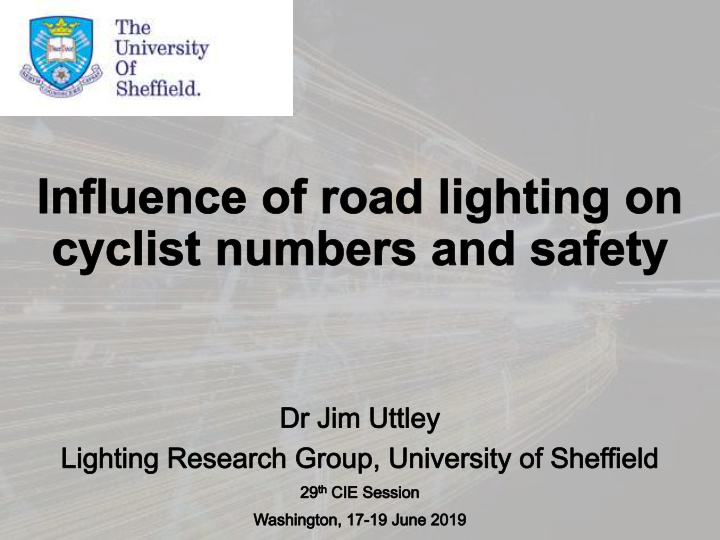



Three questions for today… 1) Can lighting encourage more cycling after-dark? 2) How does lighting affect cyclist’s ability to see hazards? 3) What else needs considering alongside lighting, to make cycling safe at night?
Three questions for today… 1) Can lighting encourage more cycling after-dark? 2) How does lighting affect cyclist’s ability to see hazards? 3) What else needs considering alongside lighting, to make cycling safe at night?
Quantifying effect of darkness 23:59 DARK CONTROL HOUR 21:00-21:59 20:00 CASE HOUR 18:00-18:59 Time of day 16:00 DAYLIGHT CONTROL HOUR 15:00-15:59 12:00 08:00 04:00 00:00 Aug Dec Feb Jun Apr Oct Date in year
Quantifying effect of darkness – odds ratio Case hour in daylight ÷ Case hour in darkness Control hour when Control hour when ÷ case hour in daylight case hour in darkness = Odds ratio – effect of darkness on cyclist numbers
Quantifying effect of darkness – odds ratio Case hour in daylight ÷ Case hour in darkness Control hour when Control hour when ÷ case hour in daylight case hour in darkness = Odds ratio – effect of darkness on cyclist numbers Odds ratio > 1 indicates darkness causes decrease in cyclists
Quantifying effect of darkness Significantly greater than 1 – Fewer cyclists after-dark Source: Fotios, Uttley & Fox (2017), “A whole -year approach showing that ambient light level influences walking and cycling”
Lighting data Night-time aerial photography for Birmingham – UK Environment Agency Pixel intensities provide information about brightness and colour of lighting Source: Hale et al (2013), “Mapping Lightscapes: Spatial patterning of artificial lighting in an urban landscape”
Lighting data Source: Hale et al (2013), “Mapping Lightscapes : Spatial patterning of artificial lighting in an urban landscape”
Cycling data 48 cycle counters in Birmingham Calculate odds ratio at each counter (larger odds ratio = bigger reduction in cyclists after- dark)
Illuminance and cycling after-dark
Three questions for today… 1) Can lighting encourage more cycling after-dark? 2) How does lighting affect cyclist’s ability to see hazards? 3) What else needs considering alongside lighting, to make cycling safe at night?
Cyclist obstacle detection experiment Section Plan
Cyclist obstacle detection experiment Three related experiments 30 participants Obstacle detection task, using peripheral vision Increased realism: cycling activity, dynamic fixation target Independent variables: • Overhead lighting illuminance (0.2 – 20.0 lux) • Cycle light luminance (0 – 1.0 cd/m 2 ) • Cycle light position (hub, handlebar or head) Dependent variable: • Height of obstacle when detected
Finding 1: Hub better than handlebar- mounted Cycle light luminance = 0.32 cd/m 2
Finding 2: Cycle lights ineffective Cycle light position = handlebar
Cycle lights for being seen… Video source: Allen Krughoff via YouTube, https://www.youtube.com/watch?v=QpYn4LrtH-o [clipped using https://www.kapwing.com/]
Three questions for today… 1) Can lighting encourage more cycling after-dark? 2) How does lighting affect cyclist’s ability to see hazards? 3) What else needs considering alongside lighting, to make cycling safe at night?
Detecting a cyclist – contributing factors Can lighting make a difference? Visibility Sensory Conspicuity Cognitive https://v637g.app.goo.gl/s2BFqZ6crQidjhMo6
Improving cognitive conspicuity ‘Fault - based’ vs ‘Presumed liability’ prosecution system Country Type of law Cyclist modal Cyclist fatalities share per billion km Denmark Presumed liability 18% 5-15 Germany Presumed liability 10% 15-20 Netherlands Strict liability 26% 8-12 Switzerland Presumed liability 6% Not available UK Fault-based 2% 25-40 United States Fault-based 1% 55-60 Source for table: RoadShare (2014). The case for presumed liability on Scotland’s roads. Available online: http://www.roadshare.co.uk/research [accessed 10/06/2019]
Improving cognitive conspicuity ‘Fault - based’ vs ‘Presumed liability’ prosecution system Presumed liability shifts responsibility for collisions to driver
Three questions for today… 1) Can lighting encourage more cycling after-dark? 2) How does lighting affect cyclist’s ability to see hazards? 3) What else needs considering alongside lighting, to make cycling safe at night?
Thanks for listening j.uttley@sheffield.ac.uk https://www.jimuttley.co.uk/ http://www.lightingresearch.group.shef.ac.uk/ New CIE Research Forum – Lighting for Cyclists Thursday 20 th June, 2:00 – 3:30pm, Thurgood Marshall East
Recommend
More recommend